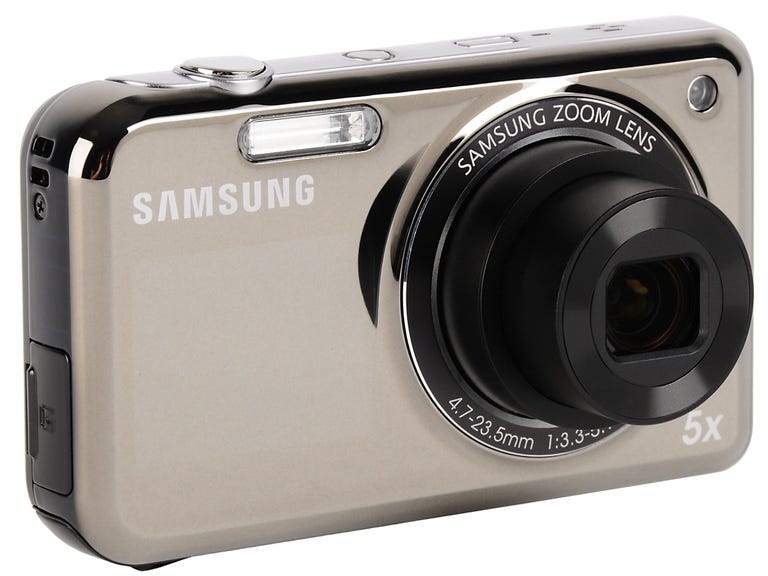 Why You Can Trust CNET
Why You Can Trust CNET Samsung PL120 review: Samsung PL120
It would be easy to dismiss the Samsung PL120's dual-screen feature as a gimmick but it's actually pretty useful for taking self-portraits. If that's not something you tend to do, though, there are better cameras available at a similar price.
The Samsung PL120 compact camera stands out from its rivals thanks to its zany front-facing screen, which promises to let you snap self-portraits without having to hand your snapper to a stranger -- and we all know that most strangers are opportunistic thieves. But is the extra display really enough to warrant £110 of your hard-earned cash?
The Good
The Bad
The Bottom Line
Double dip
We've all been there. Rather than trusting a passing stranger with your camera when you want a photo of yourself, you flip the camera around, hold it at arm's length and shoot blindly, in the vain hope that you catch something more than just the top of your head.
Rarely does this trick yield satisfactory results, which is presumably why some cleverdicks in Samsung's design team came up with the wizard wheeze of including a secondary screen on the front of the PL120. Point the lens at yourself and you can use the front-facing display to compose your shot. Suddenly, self-portraits aren't quite as hit and miss as they used to be.
The second screen isn't very big -- in fact, it's only 1.5 inches across, with a resolution of just 61,000 pixels. But it doesn't need to be huge -- it just has to be large enough to let you line up shots of yourself that actually include your face. There's a much larger, 2.7-inch screen in the usual place on the back of the camera for standard, non-narcissistic use.

At a glance, the camera doesn't actually appear to have a front-facing screen at all. When the front display is switched off, you can barely notice it's there. Press a certain button on the top of the unit, though, and it will turn on after a couple of seconds.
The screen has a secondary use too. Select the 'children' mode and the front screen displays a droll clown cartoon designed to get the kiddiewinks looking at the camera -- a sort of 'watch the birdie' for the digital age.
Run of the mill
Aside from its unusual dual-display feature, the PL120 is fairly typical of the current crop of mid-range compact cameras. It has a 14.2-megapixel image sensor and a 5x optical zoom lens with a good wide angle -- equivalent to 26mm -- which comes in handy when you're taking pictures of yourself, as it means you can fit more in the frame. You'll notice plenty of lens distortion around the edges of your shots, though.
The PL120's picture quality is acceptable for a camera of its price, but fairly unremarkable. Outdoors, in good light, colours are well reproduced, although strong tones may come across as slightly too vibrant for some people's tastes. Edges are sharp and contrast is good, but don't be surprised to find more than a little picture noise in your shots. Purple fringing can affect some edges too, particularly where there's a dark object against a light background.
The camera's interior and low-light performance is more disappointing. Despite the availability of some high-sensitivity settings, the PL120 doesn't do all that well without resorting to its built-in flash. While testing the camera in a fairly well-lit interior environment, the PL120 produced some very grainy shots at ISO 400.
You can record 720p videos, but the quality isn't very impressive, with plenty of squishy compression artefacts visible and an unpleasantly woozy feel to motion, despite the 30 frames per second rate. The accompanying sound is mono-only and there's no HDMI socket for connecting the camera to an HD-ready TV.
The PL120 isn't as intuitive as some cameras we've played with recently. The zoom control, for example, consists of an odd lever that you have to press up and down. The rest of the buttons are more traditional, but the camera's menu screens are annoying to plough through and, depending on which mode you're shooting in, you can end up with numerous icons and read-out data cluttering the screen as you try to compose a shot.
That said, there are plenty of tools for taking and editing your photos creatively. Fish-eye and vignetting filters are among them, and the camera's 'magic frame' feature can be used to add pizzazz to your photos after the fact. Alternatively, you can put your trust in the camera's smart-auto mode and simply point and shoot.
Conclusion
Whether the Samsung PL120 is the camera for you really comes down to one question -- how often do you take pictures of yourself, naked or otherwise? If the answer is 'often', it could be worth a punt. Just don't expect to be bowled over by the picture quality.
Edited by Charles Kloet


